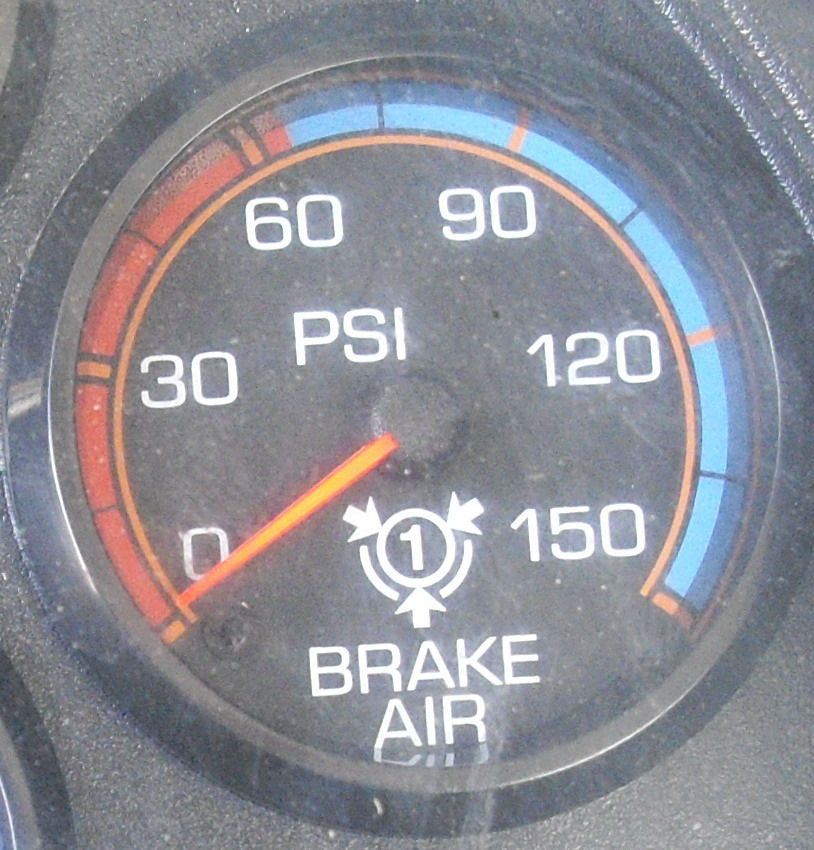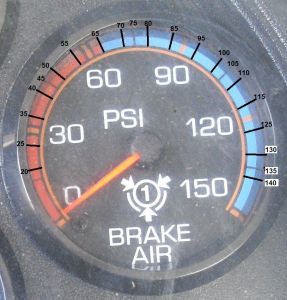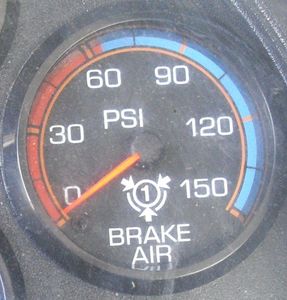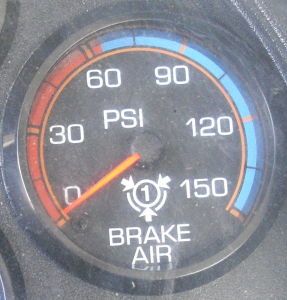Profile For Soulin H.
Soulin H.'s Info

-
Location:
-
Driving Status:
-
Social Link:
-
Joined Us:
9 years ago
Soulin H.'s Bio
No Bio Information Was Filled Out. Must be a secret.
Comments By Soulin H.
Posted: 6 years, 9 months ago
View Topic:
Help! How is anyone supposed to 'accurately" read an Air Pressure gauge like this one?
 OK I got it wrong again!
OK I got it wrong again!  Center of blue segments between 90 and 120; center of first segment (above 90) is 97 1/2 psi
second segment center between the black line and 120 is 112 1/2 psi. etc.... ...I think anyway
Center of blue segments between 90 and 120; center of first segment (above 90) is 97 1/2 psi
second segment center between the black line and 120 is 112 1/2 psi. etc.... ...I think anyway
I am not going to post here again until I pass all my DMV tests scheduled for next week and am waiting for CDL to come in the mail.
I am going to focus on all what I need to to pass the DMV tests for my CDL.
To all who undoubtedly have said something of my error/s, thanks even though I have not read any more posts and will not be answering them directly at this point in time because I will be taking a break from most computer things for the next week so I can do what I must in order to pass DMV Pre-Trip, Air Brakes, Skills, and Driving tests the first time.
Thanks everyone for your so very valuable input.
BTW, FWIW, I just want to pass the tests at DMV, I could care less about a 'Cigar'.
Posted: 6 years, 9 months ago
View Topic:
Help! How is anyone supposed to 'accurately" read an Air Pressure gauge like this one?
Re what I just said:
For the DMV test, if the needle is right at center of a red or a blue segment, I will say whatever even number it would be;
OK, I know, I made a 'technical' error; I should have said:
For the DMV test, if the needle is right at center of a red or a blue segment, I will say whatever whole number it would be;...
Posted: 6 years, 9 months ago
View Topic:
Help! How is anyone supposed to 'accurately" read an Air Pressure gauge like this one?
Oh man......that's some unfortunate math right there! No wonder you're unhappy about this gauge.
Thanks for trying.......but no cigar
 I know. Anyway I should have said 1/2 way between 90 psi and 120 psi is 105 psi.
I know. Anyway I should have said 1/2 way between 90 psi and 120 psi is 105 psi.
And yes; No Cigar!
I did ask my instructors about it. As has been said here, the reading of the gauge is important and close enough (IOW, will not have to be absolutely 'exact') in all likelihood will be close enough to pass a DMV test.
Also, as has been said here, and adamantly emphasized and insisted by my instructors, the correct psi ranges for each test must be verbalized to the DMV tester.
As I study the photo of the gauge I notice that one needle width is about 1 psi.
Increments of 30 can be evenly divided by 6 to find where the the 5 psi increments are.
There are red and blue segments that are separated by a black line centered between the numbers on the gauge. The black line is the 3rd 5 psi increment between the numbers (15 psi above and below the numbers).
The center of each red or blue segment would be about 7 1/2 psi (which is what made it more confusing to me).
For the DMV test, if the needle is right at center of a red or a blue segment, I will say whatever even number it would be; example: 117 psi for (saying) needles have settled @ (117 psi) when preforming the Air Compressor Governor Cut-In Test if the needle on gauge is center of the 'higher' psi segment between 120 and 90. I will not bother saying 117 1/2 psi.
I am am sure I have it correct enough for DMV test now.
Thanks to everyone for your input.
Posted: 6 years, 9 months ago
View Topic:
Help! How is anyone supposed to 'accurately" read an Air Pressure gauge like this one?
BTW, FWIW, Re:
Yeah, this guy is gonna be a real treat to deal with. Wait until he gets on the road one-on-one isolated with his first mentor. He's gonna give one or two smartass remarks like that and on the second day find himself sitting on the side of the road hitching a ride..
 Not going to happen.
Not going to happen.
Thanks (Raptor) You did miss one though.. ...Not meaning to be a "smrtass"... ...just saying:
Check Rate of Air Pressure Buildup To perform this test, the engine must be running at normal operating idle, typically 600–900 rpms. Observe the air gauge to determine if the pressure builds at the proper rate. For dual air systems, the pressure should build from approximately 85 to 100 psi within 45 seconds.
Posted: 6 years, 9 months ago
View Topic:
Help! How is anyone supposed to 'accurately" read an Air Pressure gauge like this one?
1 Re:
You are not being tested on whether you not you can read the gauge,
Actually the instructors at my school have said to me and other students otherwise. They would disagree with that statement.
Re:
Soulin, aside from my mistake, you were given the correct answer.
Yes Old School, I realize most of the answers here have been correct. I was not referring to your so humbly admitted incorrect answer.
Re:
You just can't let it get the best of you in this job. Very few things are perfectly accurate in this career. You will discover that no two trucks air compression systems act identically....
... Try to relax and not drive yourself crazy by overthinking the details. This probably sounds unprofessional to you now, but about three years into this career you'll understand me. Of course, if you think I'm crazy now, and continue stressing over the minutiae, you'll never last three years in this job. It will drive you nuts.
Thanks Old School; your points well taken, I understand. Even though I am as of yet inexperienced in the trade, I do agree with that and have life's experience with many other things that same advise; would be wise to take for sure.
I have been reading posts on this website for a couple of years now and have been absorbing the informative info that is so graciously given by so many here. It is one of the things that weighed-in for my decision to follow through and get my Class A CDL.
Re:
Your on a forum full of people who have already passed this test and your going to claim we can't help you with "Thanks for trying....But no cigar"??????
Plan B,
1- My humble apology for appearing to be smug and ungrateful with my mannerism regarding the "no cigar" comment. 2- I very much acknowledge your honest good advice. I do appreciate the photo of the gauge and your support and mention that my situation is not in the least bit unique.
2- I very much acknowledge your honest good advice. I do appreciate the photo of the gauge and your support and mention that my situation is not in the least bit unique.
Re:
Step one is simply checking for leaks. Your holding the brake down while listening for leaks and making sure the pressure does not continue to drop while you are doing so.
That test is called the "Applied Leakage" test and is for the "Service Brakes" (according to CA Manual and my instructors.) In in my school that would be step 3 but most probably could be step 1. That is just not the way I am being instructed here.
At the DMV the wording we use must be accurate. I have already have shown where by using the literal verbatim of what the CA DMV refers to as the "Static Leakage Test" as. It is for the parking and emergency brake systems which must not loose more than 3 psi after the air pressure gauges "stabilize" and in exactly 1 minute (using the tractor towing a single trailer with air brake system that we have to test in at DMV anyway.
Re:
Mr/Mrs Evaluator I am going to pump down on the brake pedal until the warning light and buzzer come on at or before 60psi."
Here we have to be 100% accurate with what the minimum and maximum (range) where the "low Air Pressure Warning" light and/or buzzer come/s on. The range here in CA is a minimum of 55 psi and a maximum of 75 psi. That being said, on the trucks that we practice on in the yard and the test truck, yes the low air pressure warning system initiates at ~ 60 psi.
BTW, FWIW, I am now quite (and have been for a few weeks now) familiar with the "Spring Brake Pop-Out" test... ...(minimum 20 psi and maximum of 45 psi... ...Also, FWIW, all of the air brake test pressure ranges and steps. I was just asking here if anyone would have a specific way to read the gauge I posted a photo of, not much more other than asking  why
anyone would make such a gauge like that (with intervals of 30 psi instead of 10 psi) in the first place.
why
anyone would make such a gauge like that (with intervals of 30 psi instead of 10 psi) in the first place.
Re:
Yeah, this guy is gonna be a real treat to deal with. Wait until he gets on the road one-on-one isolated with his first mentor. He's gonna give one or two smartass remarks like that and on the second day find himself sitting on the side of the road hitching a ride.....with no cigar.
OK Brett. I think you may be exaggerating just a wee bit on that 'second day on the road' comment. I did not realize that some would take it that way regarding my no cigar comment gee wiz!
Now I think no matter what way I explain the why I said (meant) that contextually some here would likely say that I am making excuse for what you have decided is a "smartass' remark. I just assume get back on track of the topic instead of getting so offtrack about differing ways that the 'no cigar' comment was supposedly intended by me to contextually mean... ...OK it was a smartass remark.
I will I will do my best and hopefully will not be making any more 'smartass-like comments here.
That being said, I do appreciate the wealth of information on this website and hope that I can contribute in some way in the future, or maybe something that I already asked and the answers that were or will be generated in the future have been or will be helpful to someone anyway.
Posted: 6 years, 9 months ago
View Topic:
Help! How is anyone supposed to 'accurately" read an Air Pressure gauge like this one?
The main point of the testing, is that you know how to verbalize the correct information to the officer while you're demonstrating the proper steps to take the test. They are already expecting you to show up in a properly inspected truck that's in good working order. They just want to see you demonstrate the test properly, and verbalize the information correctly.
Thanks Old School. That is the most accurate and truthful 'answer' I have read here for this topic and is what my instructors have been saying all along. As of yet, I have not read any posts beyond the one the quote above is from yet.
As for my instructors' they have been very informative and have answered every question I have asked. Yes, I have asked about the air pressure gauges. The answers I have gotten regarding that so far have not been specific but were general about having to 'learn' the increments; And yes, there is a worded 'script' we are supposed to remember for the Air Brake Test at the DMV.
It's only a sixty second test. Relax, you don't need single psi increments to look at. You'll know if it's working properly without having to get all anal with the details.
 LOL!! More paranoia than anal.
LOL!! More paranoia than anal.
I am just looking for accurate answers regarding the specific gauge I have to test with. I have received mostly 'accurate' answers and good advice here; (thanks to all for that). There has been at least 1 incorrect answer, Re: "Static Leakage Test"; for example:
For the static leakage test your basically just watching to make sure the needle doesn't continue to drop as your holding the brake.
, ...But, no answers specific to the gauge I am asking about.
Posted: 6 years, 9 months ago
View Topic:
Help! How is anyone supposed to 'accurately" read an Air Pressure gauge like this one?
RE:
You are way over thinking this. The gauge is set up for the numbers you need. 90, compressor comes on. 120, compressor cuts off. 60, warning buzzer comes on. 30, valves should pop.
Actually not. CA CDL Manual says:
"*Air Compressor Governor Cut-In Pressure Test To perform this test, the air pressure for the vehicle cannot be rising when the engine is running. With the air pressure at maximum pressure (cut-out), begin slowly pumping the brake pedal to reduce the air tank pressure. Watch the air pressure gauge between pumps to identify when the compressor cuts-in (needle starts to rise). This must occur no lower than 85 psi for a bus, and no lower than 100 psi for trucks."
Just as vague as the one you posted.
Sure is albeit different and a 2-in-one single gauge. The one in the photo I took is just the primary, the secondary is exactly same except it has the number 2 instead of the number 1 on it.
For the static leakage test your basically just watching to make sure the needle doesn't continue to drop as your holding the brake.
It is a definite fail at the DMV on the Air Brake Test to press the "Service Brake" and reefer to it as the "Static Leakage Test".
Pressing the "Service Brake" and holding it down steady for 1 minute is the "Applied Leakage Test" on the "Service Brakes".
California DMV CDL Handbook says:
"Test Air Leakage Rate There are 2 tests as follows: Static Leakage Test With a basically fully-charged air system (within the effective operating range for the compressor), turn off the engine, release all brakes, and let the system settle (air gauge needle stops moving). Time for one minute. The air pressure should not drop more than: • 2 psi for single vehicles. • 3 psi for a combination of 2 vehicles. • 5 psi for a combination of 3 or more vehicles. Important: The maximum air loss rate for a combination of 2 or more vehicles is 2 psi if the towed vehicles are not equipped with air brakes. An air loss greater than those listed above, indicate a problem in the braking system and repairs are needed before operating the vehicle.
*Applied Leakage Test
To perform this test, the vehicle’s air pressure should be built up to maximum pressure (cut-out). With the air pressure built up, shut off the engine, chock the wheels if necessary, release the parking brake (all vehicles) and the tractor protection valve (combination vehicle), and firmly apply the foot brake. Then hold the foot brake for 1 minute after stabilization of the air gauge. Check the air gauge to see that the air pressure drops no more than 3 psi in 1 minute (single vehicle) or 4 psi in 1 minute (combination vehicle) and listen for air leaks. You must identify how much air the system lost and verbalize the maximum air loss rate allowed for your vehicle. • 3 psi for single vehicles. • 4 psi for a combination of 2 vehicles. • 6 psi for a combination of 3 or more vehicles. Important: The maximum air loss rate for a combination of 2 or more vehicles is 3 psi if the towed vehicles are not equipped with air brakes. An air loss greater than those listed above, indicates a problem in the braking system and repairs are needed before operating the vehicle. Note: For testing purposes, you must be able to demonstrate this test and verbalize the allowable air loss for your vehicle. If the air loss is too much, check for air leaks and fix any that are identified. For testing purposes, identify if the air loss rate is too much.
Just sayin.
Anyway I was hoping for someone who has experience with the specific gauge scale as what I have to test with to chime-in.
Thanks to all for trying... ...  But no cigar
But no cigar
Posted: 6 years, 9 months ago
View Topic:
Help! How is anyone supposed to 'accurately" read an Air Pressure gauge like this one?
I will be taking my DMV Driving Test in a few days. My question/s: The main question is in the topic: "How is anyone supposed to 'accurately" read an Air Pressure gauge like this one?"
Why would anyone make a gauge with 30 psi increments instead of the standard 10 psi?
It seems to me so absurd! 1/2 way between 90 and 120 is 115 for example, but a driver is supposed to be able to 'accurately' read 3 psi for the Static Leakage Test after, of course, 'accurately' reading the air pressure after the readings on the gauges have 'stabilized'.
On this gauge, where exactly is 100 psi, or 85 psi?... ...what about 140 psi?... ...or 20, and 45 psi?... ...etc.

Posted: 6 years, 10 months ago
View Topic:
10/2 Sleeper Berth 'Exception' / How to use and stay 'legal'
Thanks Rainy D. and Old School for sharing your useful and informative info.










 TT On Facebook
TT On Facebook
Posted: 6 years, 9 months ago
View Topic:
Help! How is anyone supposed to 'accurately" read an Air Pressure gauge like this one?
Hi all. I passed all the DMV tests!

The instructors were helpful. I was able to get it correct how to read the air pressure gauges.
I admit I was stressing a bit over it but I got over it and put my head into it.
Thanks to everyone that chimed-in.
Here is the photo of the same gauge that I added some lines and psi numbers to illustrate. I just did the best I could with the Microsoft paint program, did not use a micrometer so the lines are not 'exact' but as some have said here (thanks to those that did say) does not have to be dead-on exact. Close enough to the 'exact' reading and knowing the parameters for each particular test is what matters to pass.
Also to be closer to 'exact', one pointer needle width at the tip of the needle is about 1 psi. I did when I read the gauge end up saying the reading is 104 psi because that is where it was pointing about 1 pointer needle width lower than right on the 105 psi line.
so the lines are not 'exact' but as some have said here (thanks to those that did say) does not have to be dead-on exact. Close enough to the 'exact' reading and knowing the parameters for each particular test is what matters to pass.
Also to be closer to 'exact', one pointer needle width at the tip of the needle is about 1 psi. I did when I read the gauge end up saying the reading is 104 psi because that is where it was pointing about 1 pointer needle width lower than right on the 105 psi line.